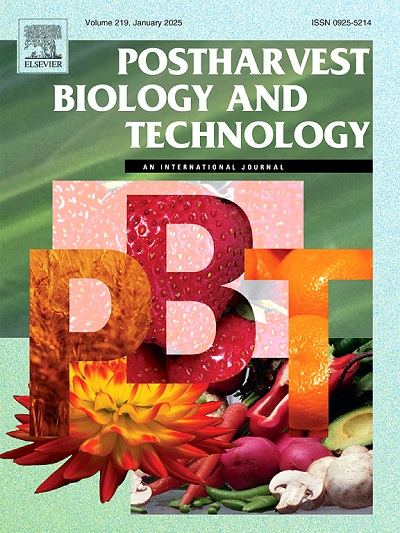Ozone treatment controlled postharvest table grape blue mold by targeting cell membrane to cause membrane integrity disruption and inhibited the development of Talaromyces rugulosus and accumulation of ochratoxin A
IF 6.4
1区 农林科学
Q1 AGRONOMY
引用次数: 0
Abstract
Talaromyces rugulosus is a prevalent and devastating fungus responsible for table grapes blue mold and is capable of metabolizing ochratoxin A (OTA), which leads to substantial economic losses and poses potential health risks to human. This study investigates the effects of ozone fumigation on controlling postharvest blue mold caused by T. rugulosus, as well as the potential mechanisms of action. The results demonstrated that ozone treatment (2.0 mg L−1) inhibited the expansion of blue mold caused by T. rugulosus in both ‘Sunshine Rose’ and ‘Red Globe’ grape varieties. In vitro experiments showed that ozone suppressed mycelial growth and spore germination by altering the ultrastructural morphology of both spores and hyphae. In addition, ozone treatment led to a significant improvement in reactive oxygen species (ROS) levels that increased malondialdehyde (MDA) content, electrical conductivity and caused leakage of proteins and nucleic acids, ultimately, deeply damaging cell membrane integrity. Molecular docking experiments indicated that ozone interacted with key proteins, ERG6 and ERG27, involved in ergosterol synthesis on the cell membrane, forming intermolecular hydrogen bonds. This interaction downregulated the relative expression of TrERG6 and TrERG27, thereby inhibiting ergosterol synthesis and reducing ergosterol content. Furthermore, ozone also reduced OTA accumulation by down-regulating the relative expression of crucial genes involved in OTA biosynthesis, including polyketide synthase (PKS), non-ribosomal peptide synthetase (NRPS), cytochrome P450 (P450), and ethanol dehydrogenase (ADH). Finally, ozone decreased weight loss, delayed the decline in the total soluble solids, vitamin C content, titratable acid and reducing sugars, which maintained the nutritional and edible quality of the grapes.
臭氧处理对采后食用葡萄蓝霉的防治作用是通过靶向细胞膜破坏膜的完整性,抑制褐藻的生长和赭曲霉毒素A的积累
rugulosus Talaromyces rugulosus是一种流行的破坏性真菌,负责鲜食葡萄蓝霉病,能够代谢赭曲霉毒素a (OTA),导致巨大的经济损失,并对人类健康构成潜在风险。本研究探讨了臭氧熏蒸对蓝霉采后的防治效果及其可能的作用机制。结果表明,臭氧处理(2.0 mg L−1)抑制了“阳光玫瑰”和“红地球”葡萄品种蓝霉病的扩散。体外实验表明,臭氧通过改变孢子和菌丝的超微结构形态来抑制菌丝的生长和孢子的萌发。此外,臭氧处理导致活性氧(ROS)水平显著提高,丙二醛(MDA)含量增加,电导率增加,导致蛋白质和核酸泄漏,最终严重破坏细胞膜完整性。分子对接实验表明,臭氧与细胞膜上参与麦角甾醇合成的关键蛋白ERG6和ERG27相互作用,形成分子间氢键。这种相互作用下调了TrERG6和TrERG27的相对表达,从而抑制麦角甾醇合成,降低麦角甾醇含量。此外,臭氧还通过下调参与OTA生物合成的关键基因的相对表达来减少OTA积累,包括聚酮合成酶(PKS)、非核糖体肽合成酶(NRPS)、细胞色素P450 (P450)和乙醇脱氢酶(ADH)。最后,臭氧减缓了葡萄的失重,延缓了葡萄可溶性固形物总量、维生素C含量、可滴定酸和还原糖含量的下降,保持了葡萄的营养和食用品质。
本文章由计算机程序翻译,如有差异,请以英文原文为准。
求助全文
约1分钟内获得全文
求助全文
来源期刊

Postharvest Biology and Technology
农林科学-农艺学
CiteScore
12.00
自引率
11.40%
发文量
309
审稿时长
38 days
期刊介绍:
The journal is devoted exclusively to the publication of original papers, review articles and frontiers articles on biological and technological postharvest research. This includes the areas of postharvest storage, treatments and underpinning mechanisms, quality evaluation, packaging, handling and distribution of fresh horticultural crops including fruit, vegetables, flowers and nuts, but excluding grains, seeds and forages.
Papers reporting novel insights from fundamental and interdisciplinary research will be particularly encouraged. These disciplines include systems biology, bioinformatics, entomology, plant physiology, plant pathology, (bio)chemistry, engineering, modelling, and technologies for nondestructive testing.
Manuscripts on fresh food crops that will be further processed after postharvest storage, or on food processes beyond refrigeration, packaging and minimal processing will not be considered.
 求助内容:
求助内容: 应助结果提醒方式:
应助结果提醒方式:


